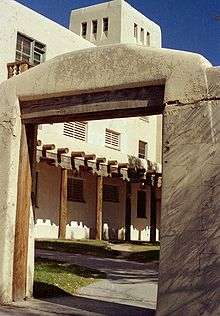Viga (architecture)


Vigas are wooden beams characteristic of older adobe construction in the southwestern United States of America, and commonly encountered for ornamental rather than functional purposes in Pueblo Revival Style architecture. They are significant in the archaeology of the American Southwest, because construction techniques used by ancestral Puebloan peoples have left intact vigas in some structures and distinctive holes in cliff faces where cliff dwellings were constructed where the vigas have subsequently deteriorated.
Modern use of the viga as an ornamental, rather than structural (weight-bearing), feature dates to construction of public buildings in New Mexico during the 1920s and 1930s. Noted architect John Gaw Meem incorporated ornamental vigas into many of his designs. Contemporary construction in Santa Fe, New Mexico, which is controlled by stringent building codes, typically incorporates ornamental vigas, although the latest revision of the residential building code gives credit for structural vigas. [1] Older structures that have been reconstructed (e.g. the Palace of the Governors in Santa Fe) may contain both structural and ornamental vigas.
Composition
In a study of modern ornamental viga use,[2] the Southwest Sustainable Forestry Partnership Marketing Project found that modern vigas are typically about 10 inches in diameter and average 15 feet long. Where available, Engelmann spruce is the preferred wood "for the wood character and lack of cracking," but Ponderosa pine is more commonly used.
See also
Notes
- ↑ City of Santa Fe (2012-01-11). "Draft Revisions to the Santa Fe Residential Green Building Code". Retrieved 2012-07-02.
- ↑ Southwest Sustainable Forestry Partnership Marketing Project (2009-08-29). "The Use of Wood Vigas in the Southwest Custom Home Market". Retrieved 2009-11-25.
References
- Bunting, Bainbridge (1983). John Gaw Meem: Southwestern Architect. Albuquerque: University of New Mexico Press. ISBN 0-8263-0251-3